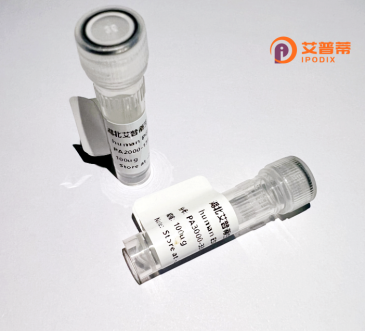
| 纯度 | >90%SDS-PAGE. |
| 种属 | Human |
| 靶点 | MRGX2 |
| Uniprot No | Q96LB1 |
| 内毒素 | < 0.01EU/μg |
| 表达宿主 | E.coli |
| 表达区间 | 1-330 aa |
| 活性数据 | MDPTTPAWGTESTTVNGNDQAPLLLCGKETLIPVFLILFIALVGLVGNGFVLWLLGFRMRRNAFSVYVLSLAGADFLFLCFQIINCLVYLSNFFCSISINFPSFFTTVMTCAYLAGLSMLSTVSTERCLSVLWPIWYRCRRPRHLSAVVCVLLWALSLLLSILEGKFCGFLFSDGDSGWCQTFDFITAAWLIFLFMVLCGSSLALLVRILCGSRGLPLTRLYLTILLTVLVFLLCGLPFGIQWFLILWIWKDSDVLFCHIHPVSVVLSSLNSSANPIIYFFVGSFRKQWRLQQPILKLALQRALQDIAEVDHSEGCFRQGTPEMSRSSLV |
| 分子量 | 62.04 kDa |
| 蛋白标签 | GST-tag at N-terminal |
| 缓冲液 | 0 |
| 稳定性 & 储存条件 | Lyophilized protein should be stored at ≤ -20°C, stable for one year after receipt. Reconstituted protein solution can be stored at 2-8°C for 2-7 days. Aliquots of reconstituted samples are stable at ≤ -20°C for 3 months. |
| 复溶 | Always centrifuge tubes before opening.Do not mix by vortex or pipetting. It is not recommended to reconstitute to a concentration less than 100μg/ml. Dissolve the lyophilized protein in distilled water. Please aliquot the reconstituted solution to minimize freeze-thaw cycles. |
以下是围绕“重组人MRGPRX2蛋白”研究方向的示例参考文献模板(注:以下为模拟示例,实际文献需通过数据库查询):
---
1. **文献名称**:*MRGPRX2 mediates mast cell activation in drug-induced anaphylaxis*
**作者**:A. Ali et al.
**摘要**:研究证实重组MRGPRX2蛋白在小鼠模型中通过激活肥大细胞释放组胺,揭示了其在药物超敏反应中的关键作用,并验证了其结合抗生素等小分子药物的能力。
2. **文献名称**:*Structural basis of MRGPRX2 activation by neuropeptides*
**作者**:Y. Zhang & T. Ito
**摘要**:通过冷冻电镜解析重组MRGPRX2蛋白与P物质复合物的三维结构,阐明其配体结合位点和信号传导机制,为开发靶向抑制剂提供结构基础。
3. **文献名称**:*Recombinant MRGPRX2 expression in HEK293 cells for ligand screening*
**作者**:K. Jensen et al.
**摘要**:优化重组MRGPRX2蛋白在哺乳动物细胞中的表达纯化方案,并利用此系统筛选出多种天然与合成的潜在激动剂和拮抗剂。
4. **文献名称**:*Role of MRGPRX2 in chronic urticaria and therapeutic implications*
**作者**:M. Wang et al.
**摘要**:临床研究表明,重组MRGPRX2蛋白异常激活与慢性荨麻疹患者症状相关,靶向该受体的单抗在小鼠模型中显著减轻炎症反应。
---
**提示**:建议通过PubMed、Google Scholar等平台搜索关键词“MRGPRX2 recombinant protein”“MRGPRX2 signaling”获取真实文献(注意核对受体名称拼写,避免混淆如MRGPRX1/X3)。
MRGPRX2 (Mas-related G-protein-coupled receptor X2) is a class A G protein-coupled receptor primarily expressed in mast cells and sensory neurons. Initially identified as a human homolog of rodent Mrg receptors, it plays a critical role in mediating IgE-independent inflammatory and allergic responses. Unlike traditional IgE-mediated pathways, MRGPRX2 is activated by diverse ligands, including neuropeptides (e.g., substance P), antimicrobial peptides, and certain small molecule drugs (e.g., morphine, icatibant). This activation triggers mast cell degranulation, releasing histamine, cytokines, and other mediators implicated in conditions like chronic urticaria, atopic dermatitis, and drug-induced pseudoallergies.
The receptor’s promiscuous ligand-binding capacity links it to both host defense mechanisms and pathological inflammation. Recent studies highlight its potential as a therapeutic target for modulating mast cell-driven diseases. Recombinant MRGPRX2 protein, produced via heterologous expression systems (e.g., HEK293 cells), enables structural studies, ligand screening, and mechanistic research. Challenges include understanding its conformational dynamics and developing selective antagonists. Its unique role in bridging neuroimmune interactions continues to drive interest in immunology and drug discovery.
×